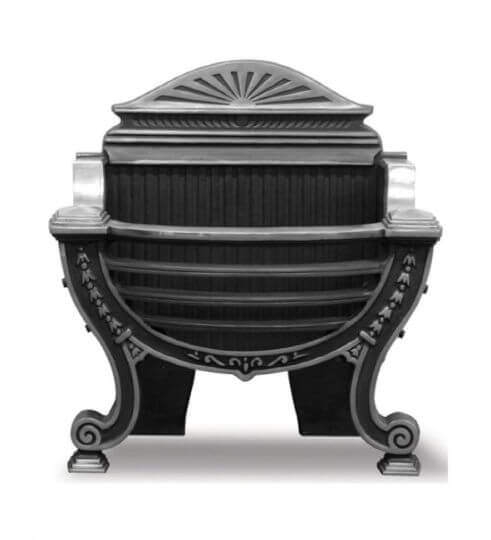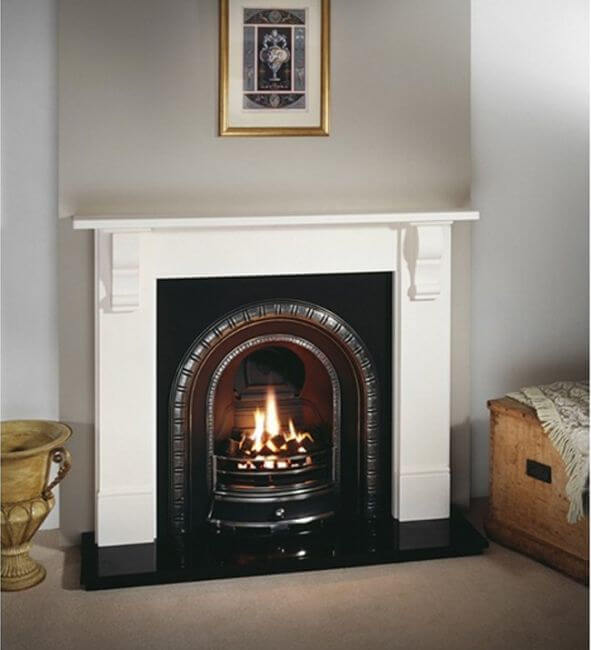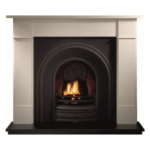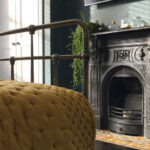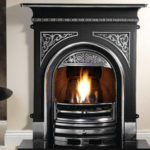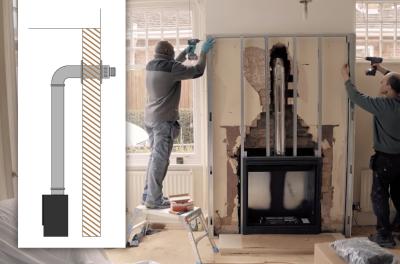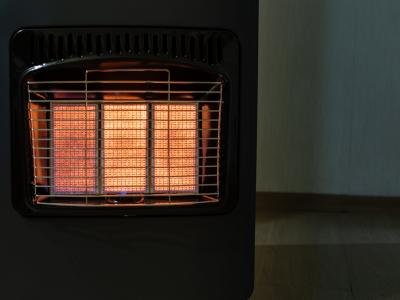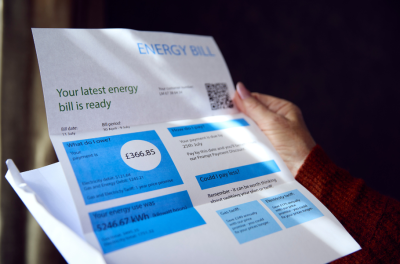We use cookies to improve your experience and our business. See our privacy/cookie policy or continue browsing to accept our use of cookies. View our cookie policy.
Everything You Need to Know About Opening up an Old Fireplace
While at one time most houses had an open fireplace, today many of them have been blocked up in favour of more efficient and eco-friendly heating methods. In fact, many homes built today don’t have a fire at all!
So, for those who love the character an open fire can give to a room, opening up a fireplace that has been hidden away is an exciting possibility.
There is, however, plenty you need to know before you start knocking through your wall! In this guide, we go through what you need to consider, including how to figure out whether you a fireplace at all and what to do once you find it...
What to Consider Before Opening Up a Fireplace
Before you get carried away with the idea of opening up your fireplace, there are a few considerations to make first, such as...
- What will you use it for? Will you be opening up your fireplace for decoration only? Or will you want to use it again? This will have an impact in how much work will need to be done.
- What type of chimney do you have? If you have a class 2 prefabricated flue, you won’t be able to burn solid fuel in your fireplace. So, unless you are doing it for decorative reasons only, it might not be worth it unless you have a class 1 brick chimney - find out before you start the work.
- Changes might be subject to building regulations. If you alter the chimney in any way, you will have to notify your local building control authority. If you want to burn a fire in it again, you will be required to ensure it is in good condition, relining it if necessary.
- There may be future maintenance. Again, if you plan on burning solid fuel, you will need to get the chimney swept regularly and see to any other additional maintenance issues.
Related: What Kind of Chimney Do I Have For My Fire?
How Do You Know if You Have a Fireplace to Reopen?
There are a couple of circumstances under in which you might have a fireplace worth reopening:
- The fireplace opening is completely boarded up - in this case, you will probably have a chimney breast that has no fireplace at all, just a smooth wall.
- A larger fireplace opening has been blocked up around a smaller gas or electric fire - in this case, you might want to reveal the larger original recess also known at the ‘builders opening’. If you have a class 1 chimney but have a gas or electric fire installed, this could apply to you.
The main problem with reopening a fireplace is that you just don’t know what you will find. While many people dream that they will pull back plaster to find a stunning period fireplace waiting for them, unfortunately this is rarely the case!
See if you can do some research into your property first. If your house was built in the first half of the 1900s, it may well be that you have a period fireplace waiting for you. For more modern houses, your chances are smaller. If you can find any past surveys on your home, this might give you an insight into whether you have a fireplace to reopen.
Neighbours can also be a good source of information - ask them if they have ever investigated their fireplace or if they have tried opening it up themselves.
If the fireplace is covered with plaster board, the first tell-tale sign is a hollow sound when you knock on the spot where the opening is located. If it has been bricked up completely, you won’t have this clue.
What you may have, though, is a ventilation brick. If your fireplace was covered up properly, a vent should have been placed in the chimney breast to prevent damp. See if you can remove it and look inside with a torch to get an idea of how deep it is. If you hold a flame under it and it is drawn towards the opening, this is a sign you have a working chimney.
Finally, you could also check pulling back your floor covering to see if there is a hearth present. This is usually a thick, heavy slab embedded into the ground and will be a good sign you have a worthwhile fireplace to reopen.
How to Open Up a Fireplace…
If you don't know what you are going to find when you reopen your fireplace, it is vital that you proceed with caution!
There are a few fireplace parts and terms you should be aware of, too:
- The lintel - this is a horizontal beam placed along the top of the opening that supports the chimney. It could be made of stone, brick steel or concrete. It’s important you do not remove this - or if you do replace it, you provide the chimney with enough support first
- The jambs - these are the ‘legs’ on either side of the fireplace opening. You only want to remove any brick or plaster work up to this point.
- The recess - this is the original structural opening that you are aiming to restore - be careful not to chip away into this!
Before you start any work, get a skip ready for any rubble and lay down protective sheets, as you will create a lot of dust while the work takes place.
1. Remove any existing fire and surround
If you have a gas fire or electric fire that you need to remove first, ensure it is done so safely. Always be careful of any gas pipes or electrical wiring when knocking through the fireplace. Take a look at our guide to find out how to remove your fire surround easily - if you get it off neatly, you could look into selling it.
2. Break through the plaster
Using a hammer and chisel, begin to break away the plaster covering the fireplace opening. Use the hearth or air vent as a guide for where this should be. In most cases, removing the top layer of plaster from the wall should reveal the shape of the original opening.
4. Continue to excavate the fireplace opening
If the fireplace opening has been bricked up, get to work with a hammer and knock through until you reach the jambs and lintel - any cracks or damage to these parts will need to be fixed. If you had a gas fire previously, you might find the gas liner coming through the chimney. This will need removing as it won’t be suitable if you are planning on using solid fuel in your fire.
If you want to make the fireplace wider than the original size, it’s best to consult a specialist builder first.
5. Inspect the recess and chimney
Once you have fully exposed the original opening, it’s important you get the full fireplace and chimney checked for
damage, especially if you plan on using it for a solid fuel fire again. Any cracks in the fireback can be repaired with fire cement. If the chimney has been capped or blocked off, this will also need opening up before you can use it again.
The chimney will need to be swept, too, as there could be some debris up there. A professional chimney sweep should also be able to let you know what state the flue is in, and if any repairs need to be done.
Finally, it’s a good idea to see how well the draught is performing. Hold a candle inside the recess and see if the smoke draws upwards. Now might be a good time to insulate the chimney if you want to use it again.
What to Do With Your Opened Up Fireplace
So, now you’ve opened up your fireplace and are left with a skip full of rubble and some bare brickwork - what do you do now?
First of all, always ensure your chimney and hearth both adhere to all building regulations before reusing your fireplace again.
We have a guide on how to buy the right hearth for your fireplace here.
Restoring Your Fireplace
Most people reopen a fireplace to restore it as a key feature of the room. There are a number of different things you can do to your new open fireplace, such as...
Cast Iron Inserts
If you were lucky enough to find an old cast iron fire hidden behind the plaster, take a look at our blog post on how to restore a cast iron fireplace for some tips on how to clean it up. If your recess is empty, you might want to put in a new cast iron fireplace insert to help bring back some of its former glory.

Pictured: Cast Tec Ardley Cast Iron Fire Insert
Fire Baskets
Alternatively, you could place a fire basket inside, either to burn fuel in or to be purely decorative. You can also find electric fire baskets and gas fire baskets, if these are more suitable.
Paint the Fireplace
For those opening up a fireplace for decoration only, painting it is a popular option. There are plenty of decor options to get creative with, whether you fill it with logs, candles, plants or books - whatever appeals to you!
We’ve got a guide on how to paint a fireplace here.
Fit a New Fire Surround
We think every fireplace deserves a crowning fire surround! If you want to create a period feel, marble fire surrounds look stunning, while cast iron fire surrounds look instantly authentic. For a clean and modern fireplace, an agean limestone surround is perfect, while wood surrounds are incredibly versatile.
Should You Remove the Fireplace Entirely?
If you have gone through the process of opening up your fireplace and just don’t think it is worth it, you can go down the route of removing your chimney breast entirely.
Some people choose to do this to create more space in their living room. It doesn’t mean you can’t have a fire, either - balanced flue gas fires, flueless gas fires and electric fires can still both be installed without a chimney.
Take a look at our blog on whether you should remove your chimney breast for more information.
Looking for a new fireplace? Shop online with Direct Fireplaces today to find everything you need including fire surrounds, hearths, fires and more!
More front the Direct Fireplaces blog…
Can You Put a TV Over a Fireplace? | How Much Does it Cost to Put in a Fireplace? | Should You Convert Your Open Fireplace Into a Gas Fire?
[related_products is_auto_added="1"]direct fireplaces
Latest posts by direct fireplaces (see all)
- Which Electric Fireplace Gives the Most Heat? - February 5, 2021
- Retro Fires and Retro Stoves for the Home - January 22, 2021
- Do I Need a Fireplace in My New Home? - January 20, 2021





